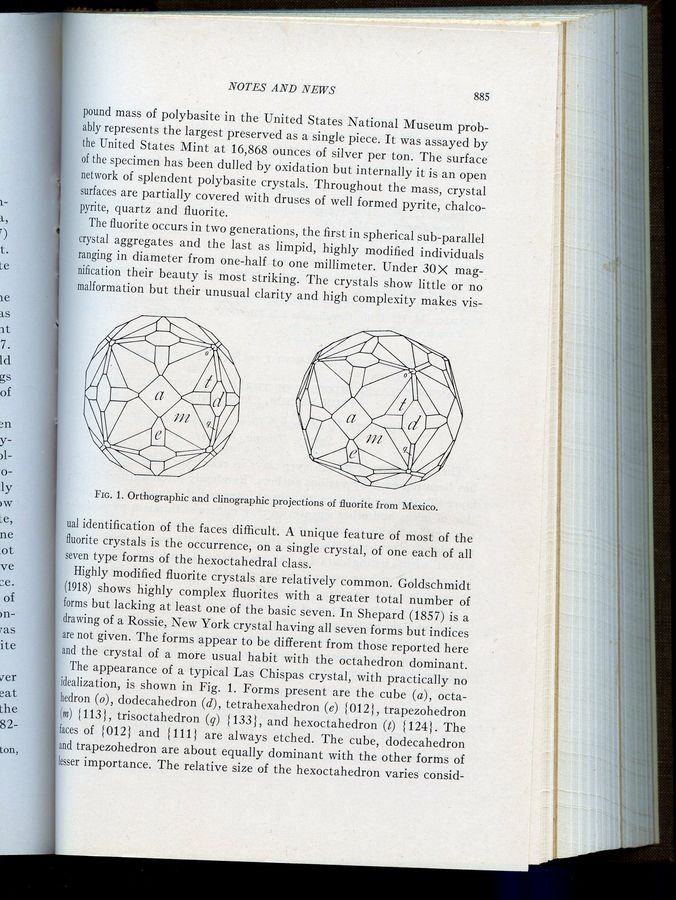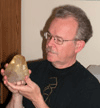| View previous topic :: View next topic |
| Author |
Message |
Philip Mostmans
Joined: 08 Nov 2011
Posts: 43
Location: Mechelen



|
 Posted: Aug 24, 2014 09:57 Post subject: Fluorite crystal morphology Posted: Aug 24, 2014 09:57 Post subject: Fluorite crystal morphology |
|
|
I was wondering if there is a scientific name when crystal edges or faces appear to be modified by the same crystal habit? I've often seen the word "stepped" used in these cases?
For example the Fluorites from Anhui Province (Jingbian mine) ( https://www.mindat.org/photo-579441.html ). Some of the the edges appear to have been formed by slightly smaller/larger cubes, sometimes at a different angle compared to the previous "step". When there are a lot of these steps, this almost looks like Rhombododecaedral modifications of the Cube.
When the sizes of the cubes vary to a greater extend you get steps in the crystal face (smaller cubes slightly sticking out of the crystal face of the larger cube).
|
|
| Back to top |
|
 |
Peter Seroka
Joined: 13 Oct 2012
Posts: 17
Location: L'Escala



|
 Posted: Aug 24, 2014 16:16 Post subject: Re: Fluorite crystal morphology Posted: Aug 24, 2014 16:16 Post subject: Re: Fluorite crystal morphology |
|
|
Hi Philip
the scientific term you're looking for is "Polysynthesis" . The special "stepped" crystals you refer to are sometimes called "Aztec pyramides" (by collectors).
If you are interested in learning more about the processes, how and by which parameters such "stepped" crystals had been formed, you may have a look at my fluorite book, chapter "Wachstum (Growth)", sub-chapter "Polysynthese". (the book is in German, however, I am sure you will easily understand the texts and mainly the drawings of different polysynthetic fluorite crystals).
https://www.mineralienatlas.de/lexikon/index.php/Mineralienportrait/Fluorit/Wachstum
Regards
Peter Seroka
_________________
Like a rolling stone .... |
|
| Back to top |
|
 |
Philip Mostmans
Joined: 08 Nov 2011
Posts: 43
Location: Mechelen



|
 Posted: Aug 25, 2014 13:35 Post subject: Re: Fluorite crystal morphology Posted: Aug 25, 2014 13:35 Post subject: Re: Fluorite crystal morphology |
|
|
Hi Peter,
Thanks for the reply and the link!
|
|
| Back to top |
|
 |
John S. White
Site Admin

Joined: 04 Sep 2006
Posts: 1298
Location: Stewartstown, Pennsylvania, USA



|
 Posted: Aug 26, 2014 07:21 Post subject: Re: Fluorite crystal morphology Posted: Aug 26, 2014 07:21 Post subject: Re: Fluorite crystal morphology |
|
|
This is sort of off-topic but since the subject of fluorite morphology has been raised I would like to call attention to a little known article by my mentor at the Smithsonian, Paul Desautels. His article "Occurrence of Multi-form Fluorite from Mexico" appeared in American Mineralogist, v. 45, July-August, 1960, pp. 884-886. The fluorite he described is from the Las Chispas mine, near Arizpe, Sonora, and the crystals occur up to about 1 mm in size on massive polybasite. Unfortunately he did not describe how the crystal drawings were generated.
| Description: |
|
| Viewed: |
12887 Time(s) |

|
_________________
John S. White
aka Rondinaire |
|
| Back to top |
|
 |
prcantos
Site Admin
Joined: 17 Apr 2012
Posts: 243
Location: Granada (Spain)



|
|
| Back to top |
|
 |
Vinoterapia
Joined: 03 Feb 2009
Posts: 181
Location: Houston, Tx



|
|
| Back to top |
|
 |
Pete Richards
Site Admin

Joined: 29 Dec 2008
Posts: 846
Location: Northeast Ohio



|
 Posted: Aug 26, 2014 09:30 Post subject: Re: Fluorite crystal morphology Posted: Aug 26, 2014 09:30 Post subject: Re: Fluorite crystal morphology |
|
|
| John S. White wrote: | | This is sort of off-topic but since the subject of fluorite morphology has been raised I would like to call attention to a little known article by my mentor at the Smithsonian, Paul Desautels. (snip) Unfortunately he did not describe how the crystal drawings were generated. |
The crystal drawing program SHAPE was the first computer program for computing and drawing crystal shapes, as far as I know, and it was not published until 1980, 20 years after this article. Undoubtedly, these drawings were prepared from measurements of a crystal using a two-circle goniometer, which were then used to prepare a gnomonic projection of the crystal morphology, which in turn was used to construct the standard orthographic (straight-on) and clinographic (perspective) drawings shown, analogous to most of the drawings seen in all the old textbooks. The method has been in use at least since the mid 19th century, and is described, for example in Terpstra and Codd (1961) Crystallometry (Longmans, London)
_________________
Collecting and studying crystals with interesting habits, twinning, and epitaxy |
|
| Back to top |
|
 |
|




